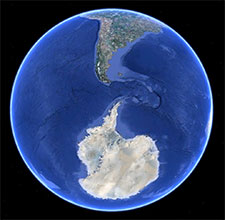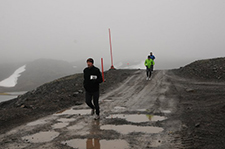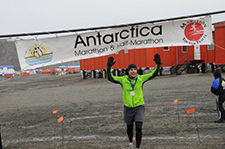Iceburgs and Insulin: Kurt Bauman?s Story
 Stretching off the coast of the southernmost tip of South America—where you are nearer to the South Pole than you are to the equator—the Drake Passage spans the distance from Cape Horn to the northern tendrils of Antarctica. There, the Atlantic and Pacific Oceans come together in a contentious clash, bottlenecked into a relatively narrow passageway five hundred miles wide.
Stretching off the coast of the southernmost tip of South America—where you are nearer to the South Pole than you are to the equator—the Drake Passage spans the distance from Cape Horn to the northern tendrils of Antarctica. There, the Atlantic and Pacific Oceans come together in a contentious clash, bottlenecked into a relatively narrow passageway five hundred miles wide.
The Drake Passage is not kind. It boasts the world’s roughest waters, with forty-foot waves, gale-force winds, and ice chunks the size of sedans. Barricaded by the two largest oceans on the planet, it batter ships with towering swells that send the bow skyward before slamming it back to the water, leaving all on board to lurch violently up and down… and up… and down!… and… up… and… down!… for days at a time. The Drake Passage exists in a sort of maritime purgatory, separating civilization from the most isolated landmass on the globe and prompting seasick travelers to question the value of life—or at least what strange force possessed them to sign up for such a hellish excursion in the first place.
 For Kurt Bauman, it was a marathon.
For Kurt Bauman, it was a marathon.
“My brother said, ‘Listen, if we’re gonna do this, we have to do Antarctica. We’re going to have to knock off Antarctica.’” Bauman shrugs. “And I said okay.”
“This” is running a marathon on each of the seven continents.
It’s not the kind of feat you’d expect from someone who describes himself as “not particularly athletic.” Despite his lean build, he was the slowest runner on a ninety-man football team, where he “played” guard, center, and tackle. As Bauman explains it: he sat in the center of the bench, guarded the water, and tackled anyone who tried to get to it. “We won three state championships,” he says, “and I watched most of it from the sidelines.” Just a few years ago, a former teammate came up to him and asked, in fond remembrance, how he managed to run so slowly.
“When you tell people you run marathons, they automatically think you’re a track star, a former collegiate athlete, or a really fast runner,” Bauman says with a shrug. My average time is in the 4:45—4:50 range. I’m not breaking any records, but I get across the finish line.”
So far, Bauman has crossed the finish line of over thirty marathons and counting.
But Bauman still doesn’t consider himself a runner. He never ran track or cross country in high school. He didn’t run in college. And even though a friend weaseled him into a marathon when he was twenty-seven, he had such a miserable experience that the moment he crossed the finish line he swore on holy pavement he’d never run another.
But several years later, something changed. He began suffering from severe headaches. Constantly. His vision became blurry to the point that he could no longer read giant billboards along the interstate. He couldn’t sleep through the night without using the bathroom six or seven times. Every night. And he was thirsty, unquenchably thirsty. As a medical sales rep, Bauman had spent enough time in the industry to recognize something was wrong.
“I think I have diabetes,” he told his doctor over the phone. “I have all the symptoms.”
“You’re thin. You’re young. You don’t have it.”
Bauman persisted. “I’m heading to Chicago in a few days. Can you see me before I leave?”
They couldn’t. They told him not to blow things out of proportion. They told him they’d see him after he returned from his trip. They told him to take some aspirin.
Bauman called his sister, who was a nurse. She got him in with one of the doctors in her office. A few hours later, Bauman had a needle shoved in his arm at Barnes in West County. Healthy blood sugar levels are between 80 and 120. Bauman’s was over 750. He was admitted to hospital, where he stayed for the next three days. “You’re lucky you didn’t go to Chicago,” they told him. “You might not have come back.”
At the age of thirty-two, Bauman was diagnosed with Type 1 diabetes.
Shots. Blood sugar. An insulin pump. All day. Every day. His life now depended on it. After three decades of living without giving his pancreas a second thought (who does?), Bauman suddenly found himself hooked to a machine that kept him alive. Adding insult to the robotic pancreas in his back pocket, Bauman found that any amount of activity, no matter how small, caused his blood sugar to plummet. Even mowing the grass proved too much; after thirty minutes, he’d become so weak and dizzy he’d have to lie down. His family didn’t want him traveling alone. They worried about him driving. His life felt out of his control. He was mad. And so, he signed up for the New York Marathon.
He couldn’t even run a mile.
For eighteen weeks, Bauman trained by the seat of his pants, which was fitting, since that’s where he kept his insulin pump. It was a trial-and-error approach, with a sprinkling of Hal Higdon on the side.
“I carried food with me. I monitored my insulin pump. There was a lot of walking home. There were lots of blood sugar drops. I’d turn my insulin down on my pump before I ran. I carried GU and Power Bar Gel. But my blood sugar would still drop, and I’d have to walk home. The first time I ran five miles… that was a big deal.
“Exercise accelerates the insulin process, so I had to teach myself how not to give myself insulin so I could exercise. When your blood sugar drops, your heart starts beating, you become sweaty, your hands get clammy. But when you’re running, your body does all those things anyway.”
To make sure he wasn’t going to pass out on the side of the road, Bauman checked his blood sugar every five miles, digging into the stash of needles, test strips, and a glucose meter that he carried with him on every run. Five miles, and then he’d stop on the side of the road and prick his finger. Another five miles, another stop, another prick. If it were raining, he’d find a parked car or a tree stump or a mailbox and stick his hand under the temporary shelter so he could check his blood sugar.
Rain wreaks havoc on test strips.
One year after his diagnosis, Bauman crossed the finish line of the New York City marathon—needles and all. He cried like a baby.
Today, he’s run a marathon in thirty-one states (his goal is to check off all fifty in addition to the seven continents), and he frequently travels around the country speaking about diet, exercise, and giving diabetes a giant, “So what?”
And nothing tells the disease to—well, you know—like running a marathon on the most remote, inhospitable continent in the world.
“We were on a waiting list for three years,” Bauman says of signing up to run the Antarctica Marathon. “At the time, they only allowed one hundred runners to keep the environment pristine. They offered insurance in case something happened. You pretty much had to sign your life away.”
And your bank account. In addition to an official race t-shirt, the $8000 registration fee includes an eighteen-day journey and a ship.
“After you’ve been chosen, you have two weeks to let them know. You make the final decision. No refund. They book the ship and the whole shebang.” He shrugs. “You’re all in at that point.
“They give you a checklist of things to bring: several pairs of shoes, ice cleats, waterproof suits for the raft that you take from the ship to shore. You have to prepare for the most horrible conditions.”
Bauman’s luggage included half a suitcase filled with nothing but diabetic supplies. (“There’s no Walgreen’s there.”)
After flying to South America, Bauman, his brother, and the other runners boarded a former naval ship, four stories high and with a maximum capacity of two hundred people. Bauman’s room was on the second level. For most of the journey through the Drake Passage, the brothers’ view through the porthole was underwater.
“They prepared us by saying that we were about to go through the roughest waters in the world. They made sure we had our prescriptions for seasickness as well as the Dramamine patches, which we put on several days ahead. I remember the captain coming on the intercom saying, ‘In three hours, we will be in the Drake Passage. If you have to walk around, be careful.’ I knew it was full-on when we woke up and there were vomit bags all over the ship, spaced about five feet apart.
“All the tables and chairs are chained to the floor, but several times the chains would come unhooked, and people would fall out of their chairs. Sometimes people would fall down and roll down the hallways. At one point, the waters were so rough, our beds would flip 180 degrees and slam back down. You’d hold on to the bed so you didn’t get tossed across the room. The drawers would fly out of the dressers. We would look out our window, and all we saw was water. My brother said, ‘I think we’re gonna die.’”
This. For two full days. And then there was the marathon.
Because of environmental protection restrictions, there is no support along the course. No water stations. No port-a-potties. No medical emergency crews. Whatever hydration and nutrition race participants want along the way, they have to carry with them from mile one. In Antarctica, you are your own course support.
Then there is the strict six-hour time limit. The severe weather conditions allowed only a small window for the race before the waters would grow too rough for the rafts to carry the race participants from the island back to the ship. Cross the finish line in six hours or be pulled off the course. Period.
“Starting out the first five miles, I didn’t think I was going to make it. The winds were gusting at forty miles-per-hour. It was spitting rain and twenty degrees. We were running through water and mud the whole time. We were running in at least three to four inches of water from melted snow. The whole time I had it in the back of mind that I had to knock it out in six hours or they’d pull me off the course. My average marathons are five hours. I was terrified I wouldn’t make it.
“You keep thinking, ‘Am I going to make it? What’s the next hurdle around the corner? Another stream? Another hill? Wind?’ I had waterproof gloves, but taking them off was hard. My hands were wet and frozen. When I tried to check my blood sugar, I couldn’t feel my hands. I just squeezed my finger and hoped blood came out.”
Five hours and fifteen minutes after Bauman set foot on King George Island, Bauman crossed the finish line—that is, after a brief mid-race delay, when a parade of penguins crossed the course. (“Animals have precedent in Antarctica. We had to stop running and wait for them to cross.”)

Later that day, the wine bottles came out. It was a glorious but relatively brief celebration.
The Drake Passage awaited.
“My next marathon after that was the Philadelphia Marathon. There was no rain. It was forty degrees and a flat course. Whether it was or it wasn’t, I was like, ‘This is the best marathon ever!’” he laughs. “I tell my kids, you do something hard, you do something challenging, and the next time you do it, it’s a lot easier.”
And therein lies the why behind Bauman’s accomplishments. Three years ago, at the age of ten, Bauman’s son was diagnosed with Type 1 diabetes.
“My son’s alarm clock went off at 2:00 a.m. I said, ‘Trent, what are you doing? You’re waking everyone else up in the house.’ He said that he didn’t want to tell me, but that he’d been having accidents in bed at night. He set his alarm to wake him up so he could go to the bathroom. My heart dropped. I checked his blood sugar. It was 650.”
Bauman immediately took his son to Children’s Hospital.
“I was more teary-eyed than anyone because I knew he would have to take on this challenge the rest of his life. But he patted me on the shoulder and said, ‘Dad, don’t worry. You run marathons. I can do anything, even with diabetes.’” Bauman shakes his head. “It’s hard to stop running at that point when your son is looking up to you.”
And so, Bauman keeps running.
“He doesn’t let anything get him down. He plays baseball. He did the mile swim with the Boy Scouts. He’ll text me from across the soccer field and say, ‘Dad, this is my blood sugar. I’m doing this with my insulin. I’m eating this many carbs.’ Pretty amazing kid for thirteen years old.” The pride in his voice is evident. “Hopefully there is a little motivation around my marathons for him to keep doing what he wants.”
Amy L. Marxkors is the author of The Lola Papers: Marathons, Misadventures, and How I Became a Serious Runner. Her second book, Powered By Hope: The Teri Griege Story, will be released in 2014. Click here to receive Amy's weekly article via email.
Connect With Us
see the latest from Fleet Feet St. Louis